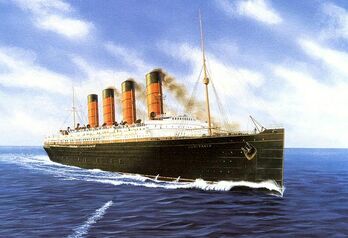
RMS Lusitania is a British ocean liner.
Bio[]
RMS Lusitania was a British ocean liner, holder of the Blue Riband, and briefly the world's largest passenger ship. She was launched by the Cunard Line in 1906, at a time of fierce competition for the North Atlantic trade. In 1915, she was torpedoed and sunk by a German U-boat, causing the deaths of 1,198 passengers and crew.
German shipping lines were agressive competitors in the transatlantic trade, and Cunard responded by trying to outdo them in speed, capacity, and luxury. Lusitania and her running mate Mauretania were fitted with revolutionary new turbine engines, able to maintain a service speed of 25 knots. Equipped with lifts, wireless telegraph and electric light, they provided 50% more passenger space than any other ship, and the first class decks were noted for their sumptuous furnishings.
When the RMS Lusitania left New York for Liverpool on what would be her final voyage on 1 May 1915, submarine warfare was intensifying in the Atlantic. Germany had declared the seas around the United Kingdom a war zone, and the German embassy in the United States had placed a newspaper advertisement warning people not to sail on Lusitania. On the afternoon of 7 May, Lusitania was torpedoed by a German U-Boat, 11 mi (18 km) off the southern coast of Ireland and inside the declared "zone of war". A second internal explosion sent her to the bottom in 18 minutes.
In firing on a non-military ship without warning, the Germans had breached the international laws known as the Cruiser Rules. Although the Germans had reasons for treating Lusitania as a naval vessel, including the fact that the ship was carrying war munitions and the British had been breaching the Cruiser Rules,[4][5][6][7][8] the sinking caused a storm of protest in the United States, as 128 Americans were among the dead. The ship's sinking provided Britain with a propaganda opportunity, which helped shift public opinion in the United States against Germany and influenced America's eventual declaration of war two years later, in 1917.
On 7 May Lusitania was nearing the end of her 202nd crossing, eastbound from New York, and was scheduled to dock at the Prince's Landing Stage in her home port of Liverpool later that afternoon. Aboard her were 1,265 passengers and a crew of 694, which combined totaled to 1,959 people. She was running parallel to the south coast of Ireland, and was roughly 11 miles off the Old Head of Kinsale when the liner crossed in front of U-20 at 14:10. Because of the liner's great speed, some believe the intersection of the German U-boat and the liner to be coincidence, as U-20 could hardly have caught the fast vessel otherwise. Schwieger, the commanding officer of the U-boat, gave the order to fire one torpedo, which struck Lusitania on the starboard bow, just beneath the wheelhouse. Moments later, a second explosion erupted from within Lusitania's hull where the torpedo had struck, and the ship began to founder in a much more rapid procession, with a prominent list to starboard.[54][55]
Almost immediately, the crew scrambled to launch the lifeboats but the conditions of the sinking made their usage extremely difficult, and in some cases impossible due to the ship's severe list. In all, only six out of 48 lifeboats were launched successfully, with several more overturning, splintering to pieces and breaking apart. Eighteen minutes after the torpedo struck, the bow struck the seabed while the stern was still above the surface, and in a manner similar to the sinking of Titanic three years earlier, the stern rose into the air and slid beneath the waves.
Of the 1,959 passengers and crew aboard Lusitania at the time of the sinking, 1,198 of the people aboard the ship lost their lives that afternoon off the coast of Ireland in the Celtic Sea. Just as had been seen with Titanic, most of the casualties were from drowning or from hypothermia. In the hours after the sinking, acts of heroism amongst both the survivors of the sinking and the Irish rescuers who had heard word of Lusitania's distress signals brought the survivor count to 764, three of whom later died from injuries sustained during the sinking. By the following morning, news of the disaster had spread around the world. While most of those lost in the sinking were either British or Canadians, the loss of 128 Americans in the disaster, including American writer and publisher Elbert Hubbard, outraged many in the United States.
Trivia[]
- Lusitania was also Titanic's rival until she was reformed.
- Lusitania was also rebuilt and became an unicorn.


